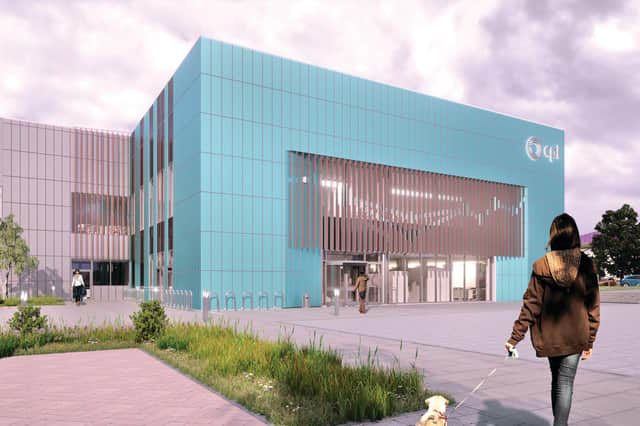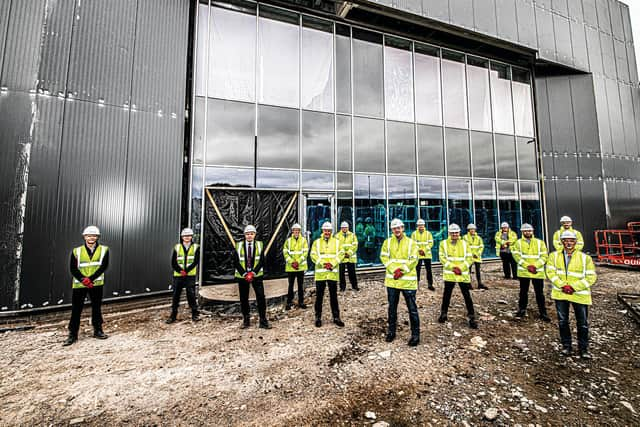How the Medicines Manufacturing Innovation Centre will bring parties together to solve ‘grand challenges’


The Medicines Manufacturing Innovation Centre is being constructed in the Advanced Manufacturing Innovation District Scotland. Its neighbours will include the National Manufacturing Institute Scotland and the Lightweight Manufacturing Centre at the nearby Westway Park.
The £56 million collaboration was launched in June 2018 as part of the £1 billion Glasgow City Region Deal, which brings together the Scottish and UK governments with the eight local councils in and around the Dear Green Place to invest in the city and its surrounding areas.
The centre is a partnership between the public and private sectors, and is led by independent technology innovation centre CPI along with founding partners: AstraZeneca, GlaxoSmithKline, Scottish Enterprise, UK Research and Innovation, and the University of Strathclyde. The site is due to be handed over to CPI early in the new year.


“It’s becoming real,” says John Arthur, director of the Medicines Manufacturing Innovation Centre, whose enthusiasm for the building is infectious.
“It’s now looking like a building. We’re no longer a virtual facility, we’re now a real facility. Soon people will be able to come and see the centre and begin to use it.”
Inside the new building, there will be four “clean rooms” for manufacturing medicines and their ingredients. The centre operates around the concept of “grand challenges”, with private and public partners coming together to identify the biggest challenges within the sector and come up with solutions, while also spotting opportunities for the pharmaceuticals industry in Scotland and the wider UK.
Three grand challenges are already under way; the first involves AstraZeneca and GlaxoSmithKline working with CPI and the University of Strathclyde to make the switch from producing tablets in batches to continuous production, which is more efficient and gives manufacturers more control. The project began at Strathclyde’s Continuous Manufacturing and Advanced Crystallisation Future Manufacturing Research Hub in Glasgow in autumn 2019 and will move to the new centre early next year. Pfizer joined the consortium in February 2021.
The second challenge involves drug makers learning a lesson from supermarkets. Instead of a “just-in-case” productionprocess –making medicines for clinical trials based on the maximum amount they are likely to need – manufacturers are developing a “just-in-time” system based on real-time demand. This is the same technique used in the food industry, to reduce the amount of stock tied up in warehouses instead of on shelves.
This challenge involves the founding partners, along with Nasdaq-listed Applied Materials. Combining the results from challenges one and two will speed up the production process for medicine manufacturing.
The third focuses on oligonucleotides, a group of materials that can be used to treat diseases by stopping our genes from producing certain proteins. The work involves Novartis,AstraZeneca and university spin-out Exactmer.
“Hopefully, by the middle of December at the latest, we’ll have the ‘go’ or ‘no-go’ decision for the next phase, following the proof of concept,” Arthur says. “That should be somewhere between a £12m and £15m manufacturing collaboration.
“Oligonucleotides are a really important field for the industry –there aren’t many out there at the moment, but there’s lots of potential with this type of drug, interfering with the expression of enzymes. The first one that we’re involved with is Novartis’s Inclisiran, an LDL cholesterol-lowering therapy, which was recommended by NICE [the National Institute for Health and Care Excellence] for use in specific high-risk patients with cardiovascular disease.
“There are other oligonucleotides being investigated as potential cancer treatments. If the UK can show it has competency in this field, we could start creating a market.
“We’re never going to get back manufacturing that’s gone to China and the Far East. But we can certainly start making thehigh-technology medicines ofthe future – including oligonucleotides.”
Arthur points to a previous pre-pandemic example, when a vaccine was being developed at Imperial College London. “They went to Austria and Canada to industrialise the technology – now that intellectual property resides abroad,” he adds.
“Having the manufacturing capability in the UK means we can hopefully develop the oligonucleotides industry here. In a nutshell, that’s what we’re trying to do – take a problem and an opportunity, bring them together, and then do something that helps advance UK manufacturing.”
Oligonucleotides also present an opportunity to cut medicines’ carbon footprint, with the potential for the nucleotides to be produced through biological rather than chemical processes, and in water rather than synthetic chemicals. The facility itself has also been built to minimise its impact on the environment, with solar panels mounted on its roof to meet some of its electricity needs, while its heating and cooling systems will be plumbed into Renfrewshire’s district heating network, which is being built by Scottish Water.
“So far, our grand challenges have involved large pharmaceutical firms but, once the centre opens, we will be able to engage with more small and medium-sized enterprises,” says Arthur. “Once the facility is open and we can start showing people around, we can start talking to them about the challenges they face in their businesses and how we can help solve them, and about the opportunities that they need help to exploit.”
Medicines Manufacturing Innovation Centre to launch digital challenge
Sitting alongside the four physical “grand challenges” that will be solved within its building, the Medicines Manufacturing Innovation Centre is also preparing to launch its first digital grand challenge. The topic will be unveiled in the coming weeks.
The challenge will bring together pharmaceutical companies and technology providers. John Arthur, director of the centre, says: “We’ll be looking at what problems the pharmaceuticals industry faces that it would like solved.
“What opportunities do the technical providers see that the industry isn’t adopting, and how do you bring those together to create something in that pre-collaborative space that everyone can get behind? The pharma sector likes technology – but it doesn’t like risk. So, how can we work together to share the costs and share the risks?”
Arthur adds that the Centre can also help pharmaceutical manufacturers and technology providers to engage with the industry’s regulator to make sure that they develop technology in a way that will win approval.
“We know that the Medicines & Healthcare products Regulatory Agency’s innovation office is really very keen to help and support the rollout of new technology,” he says.
“There’s a great opportunity to bring the industry, the technology providers, and the regulators together in a way that we can start driving technology that makes a difference to our carbon footprint, our efficiencies, our costs, our capacities, our throughputs. Reducing the cost of producing medicines makes them cheaper and more accessible.”
This article first appeared in The Scotsman’s Life Science 2021 supplement. A digital version can be found here.